Exam Details
Exam Code
:DP-100Exam Name
:Designing and Implementing a Data Science Solution on AzureCertification
:Microsoft CertificationsVendor
:MicrosoftTotal Questions
:564 Q&AsLast Updated
:Mar 29, 2025
Microsoft Microsoft Certifications DP-100 Questions & Answers
-
Question 351:
You create a datastore named training_data that references a blob container in an Azure Storage account. The blob container contains a folder named csv_files in which multiple comma-separated values (CSV) files are stored. You have a script named train.py in a local folder named ./script that you plan to run as an experiment using an estimator. The script includes the following code to read data from the csv_files folder:
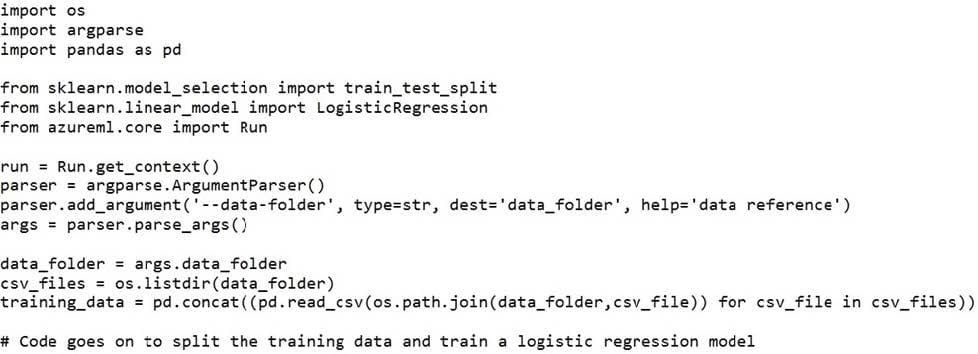
You have the following script.
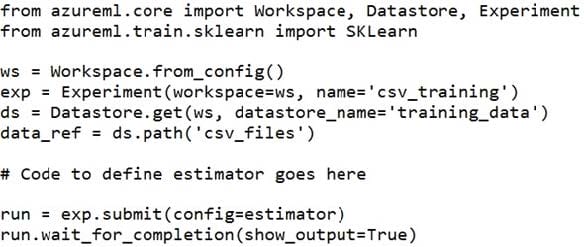
You need to configure the estimator for the experiment so that the script can read the data from a data reference named data_ref that references the csv_files folder in the training_data datastore. Which code should you use to configure the estimator?
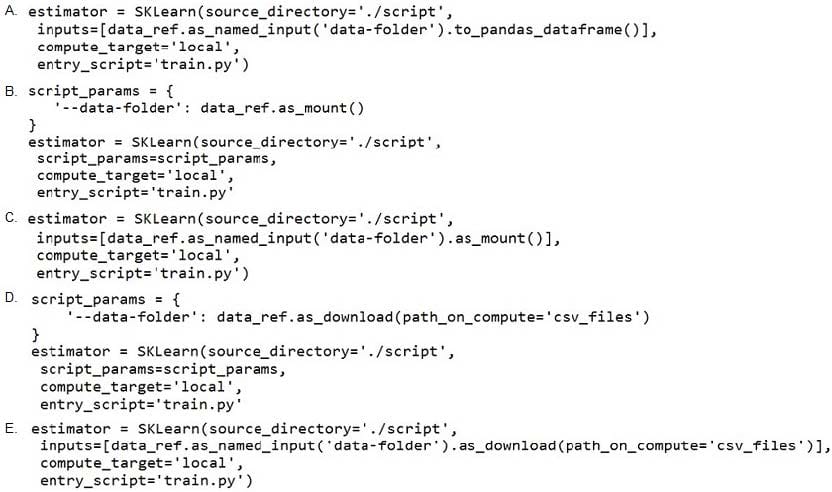
A. Option A
B. Option B
C. Option C
D. Option D
E. Option E
-
Question 352:
You write five Python scripts that must be processed in the order specified in Exhibit A ?which allows the same modules to run in parallel, but will wait for modules with dependencies.
You must create an Azure Machine Learning pipeline using the Python SDK, because you want to script to create the pipeline to be tracked in your version control system. You have created five PythonScriptSteps and have named the variables to match the module names.
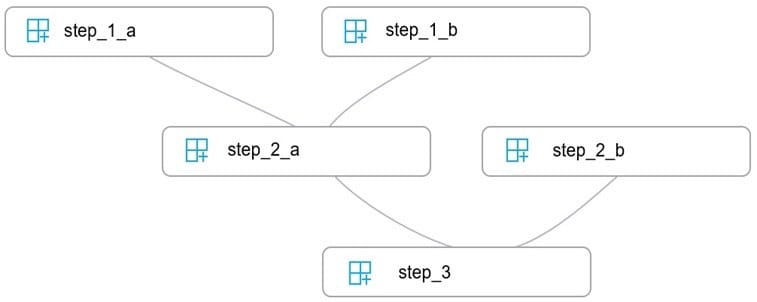
You need to create the pipeline shown. Assume all relevant imports have been done. Which Python code segment should you use?
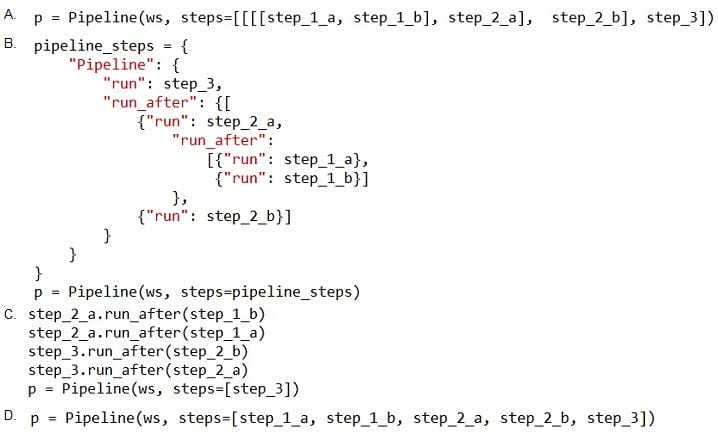
A. Option A
B. Option B
C. Option C
D. Option D
-
Question 353:
You use the following code to run a script as an experiment in Azure Machine Learning:

You must identify the output files that are generated by the experiment run.
You need to add code to retrieve the output file names.
Which code segment should you add to the script?
A. files = run.get_properties()
B. files= run.get_file_names()
C. files = run.get_details_with_logs()
D. files = run.get_metrics()
E. files = run.get_details()
-
Question 354:
A set of CSV files contains sales records. All the CSV files have the same data schema.
Each CSV file contains the sales record for a particular month and has the filename sales.csv. Each file in stored in a folder that indicates the month and year when the data was recorded. The folders are in an Azure blob container for which a datastore has been defined in an Azure Machine Learning workspace. The folders are organized in a parent folder named sales to create the following hierarchical structure:
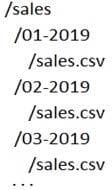
At the end of each month, a new folder with that month's sales file is added to the sales folder.
You plan to use the sales data to train a machine learning model based on the following requirements:
1.
You must define a dataset that loads all of the sales data to date into a structure that can be easily converted to a dataframe.
2.
You must be able to create experiments that use only data that was created before a specific previous month, ignoring any data that was added after that month.
3.
You must register the minimum number of datasets possible.
You need to register the sales data as a dataset in Azure Machine Learning service workspace.
What should you do?
A. Create a tabular dataset that references the datastore and explicitly specifies each 'sales/mm-yyyy/ sales.csv' file every month. Register the dataset with the name sales_dataset each month, replacing the existing dataset and specifying a tag named month indicating the month and year it was registered. Use this dataset for all experiments.
B. Create a tabular dataset that references the datastore and specifies the path 'sales/*/sales.csv', register the dataset with the name sales_dataset and a tag named month indicating the month and year it was registered, and use this dataset for all experiments.
C. Create a new tabular dataset that references the datastore and explicitly specifies each 'sales/mm- yyyy/sales.csv' file every month. Register the dataset with the name sales_dataset_MM-YYYY each month with appropriate MM and YYYY values for the month and year. Use the appropriate month- specific dataset for experiments.
D. Create a tabular dataset that references the datastore and explicitly specifies each 'sales/mm-yyyy/ sales.csv' file. Register the dataset with the name sales_dataset each month as a new version and with a tag named month indicating the month and year it was registered. Use this dataset for all experiments, identifying the version to be used based on the month tag as necessary.
-
Question 355:
You plan to provision an Azure Machine Learning Basic edition workspace for a data science project.
You need to identify the tasks you will be able to perform in the workspace.
Which three tasks will you be able to perform? Each correct answer presents a complete solution.
NOTE: Each correct selection is worth one point.
A. Create a Compute Instance and use it to run code in Jupyter notebooks.
B. Create an Azure Kubernetes Service (AKS) inference cluster.
C. Use the designer to train a model by dragging and dropping pre-defined modules.
D. Create a tabular dataset that supports versioning.
E. Use the Automated Machine Learning user interface to train a model.
-
Question 356:
Note: This question is part of a series of questions that present the same scenario. Each question in the series contains a unique solution that might meet the stated goals. Some question sets might have more than one correct solution, while
others might not have a correct solution.
After you answer a question in this section, you will NOT be able to return to it. As a result, these questions will not appear in the review screen.
You are using Azure Machine Learning to run an experiment that trains a classification model.
You want to use Hyperdrive to find parameters that optimize the AUC metric for the model. You configure a HyperDriveConfig for the experiment by running the following code:

You plan to use this configuration to run a script that trains a random forest model and then tests it with validation data. The label values for the validation data are stored in a variable named y_test variable, and the predicted probabilities from
the model are stored in a variable named y_predicted.
You need to add logging to the script to allow Hyperdrive to optimize hyperparameters for the AUC metric.
Solution: Run the following code:

Does the solution meet the goal?
A. Yes
B. No
-
Question 357:
Note: This question is part of a series of questions that present the same scenario. Each question in the series contains a unique solution that might meet the stated goals. Some question sets might have more than one correct solution, while
others might not have a correct solution.
After you answer a question in this section, you will NOT be able to return to it. As a result, these questions will not appear in the review screen.
You are using Azure Machine Learning to run an experiment that trains a classification model.
You want to use Hyperdrive to find parameters that optimize the AUC metric for the model. You configure a HyperDriveConfig for the experiment by running the following code:

You plan to use this configuration to run a script that trains a random forest model and then tests it with validation data. The label values for the validation data are stored in a variable named y_test variable, and the predicted probabilities from
the model are stored in a variable named y_predicted.
You need to add logging to the script to allow Hyperdrive to optimize hyperparameters for the AUC metric.
Solution: Run the following code:
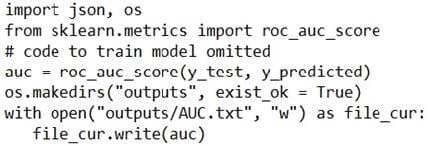
Does the solution meet the goal?
A. Yes
B. No
-
Question 358:
You are analyzing a dataset containing historical data from a local taxi company. You are developing a regression model.
You must predict the fare of a taxi trip.
You need to select performance metrics to correctly evaluate the regression model.
Which two metrics can you use? Each correct answer presents a complete solution?
NOTE: Each correct selection is worth one point.
A. a Root Mean Square Error value that is low
B. an R-Squared value close to 0
C. an F1 score that is low
D. an R-Squared value close to 1
E. an F1 score that is high
F. a Root Mean Square Error value that is high
-
Question 359:
Note: This question is part of a series of questions that present the same scenario. Each question in the series contains a unique solution that might meet the stated goals. Some question sets might have more than one correct solution, while others might not have a correct solution.
After you answer a question in this section, you will NOT be able to return to it. As a result, these questions will not appear in the review screen.
You are using Azure Machine Learning to run an experiment that trains a classification model.
You want to use Hyperdrive to find parameters that optimize the AUC metric for the model. You configure a HyperDriveConfig for the experiment by running the following code:

You plan to use this configuration to run a script that trains a random forest model and then tests it with validation data. The label values for the validation data are stored in a variable named y_test variable, and the predicted probabilities from
the model are stored in a variable named y_predicted.
You need to add logging to the script to allow Hyperdrive to optimize hyperparameters for the AUC metric.
Solution: Run the following code:

Does the solution meet the goal?
A. Yes
B. No
-
Question 360:
You plan to use a Data Science Virtual Machine (DSVM) with the open source deep learning frameworks Caffe2 and PyTorch.
You need to select a pre-configured DSVM to support the frameworks.
What should you create?
A. Data Science Virtual Machine for Windows 2012
B. Data Science Virtual Machine for Linux (CentOS)
C. Geo AI Data Science Virtual Machine with ArcGIS
D. Data Science Virtual Machine for Windows 2016
E. Data Science Virtual Machine for Linux (Ubuntu)
Related Exams:
62-193
Technology Literacy for Educators70-243
Administering and Deploying System Center 2012 Configuration Manager70-355
Universal Windows Platform – App Data, Services, and Coding Patterns77-420
Excel 201377-427
Excel 2013 Expert Part One77-725
Word 2016 Core Document Creation, Collaboration and Communication77-726
Word 2016 Expert Creating Documents for Effective Communication77-727
Excel 2016 Core Data Analysis, Manipulation, and Presentation77-728
Excel 2016 Expert: Interpreting Data for Insights77-731
Outlook 2016 Core Communication, Collaboration and Email Skills
Tips on How to Prepare for the Exams
Nowadays, the certification exams become more and more important and required by more and more enterprises when applying for a job. But how to prepare for the exam effectively? How to prepare for the exam in a short time with less efforts? How to get a ideal result and how to find the most reliable resources? Here on Vcedump.com, you will find all the answers. Vcedump.com provide not only Microsoft exam questions, answers and explanations but also complete assistance on your exam preparation and certification application. If you are confused on your DP-100 exam preparations and Microsoft certification application, do not hesitate to visit our Vcedump.com to find your solutions here.